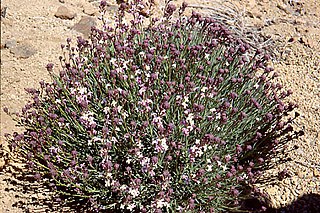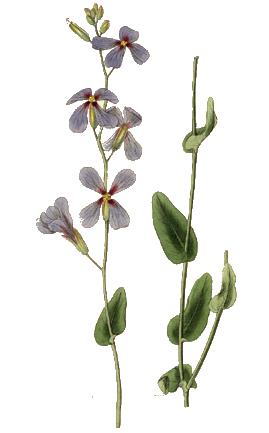Related Research Articles

The Brassicales are an order of flowering plants, belonging to the eurosids II group of dicotyledons under the APG II system. One character common to many members of the order is the production of glucosinolate compounds. Most systems of classification have included this order, although sometimes under the name Capparales.

Brassicaceae or Cruciferae is a medium-sized and economically important family of flowering plants commonly known as the mustards, the crucifers, or the cabbage family. Most are herbaceous plants, while some are shrubs. The leaves are simple, lack stipules, and appear alternately on stems or in rosettes. The inflorescences are terminal and lack bracts. The flowers have four free sepals, four free alternating petals, two shorter free stamens and four longer free stamens. The fruit has seeds in rows, divided by a thin wall.

The order Lamiales are an order in the asterid group of dicotyledonous flowering plants. It includes about 23,810 species, 1,059 genera, and is divided into about 25 families. These families include Acanthaceae, Bignoniaceae, Byblidaceae, Calceolariaceae, Carlemanniaceae, Gesneriaceae, Lamiaceae, Lentibulariaceae, Linderniaceae, Martyniaceae, Mazaceae, Oleaceae, Orobanchaceae, Paulowniaceae, Pedaliaceae, Peltantheraceae, Phrymaceae, Plantaginaceae, Plocospermataceae, Schlegeliaceae, Scrophulariaceae, Stilbaceae, Tetrachondraceae, Thomandersiaceae, Verbenaceae.
In biology, taxonomy is the scientific study of naming, defining (circumscribing) and classifying groups of biological organisms based on shared characteristics. Organisms are grouped into taxa and these groups are given a taxonomic rank; groups of a given rank can be aggregated to form a more inclusive group of higher rank, thus creating a taxonomic hierarchy. The principal ranks in modern use are domain, kingdom, phylum, class, order, family, genus, and species. The Swedish botanist Carl Linnaeus is regarded as the founder of the current system of taxonomy, as he developed a ranked system known as Linnaean taxonomy for categorizing organisms and binomial nomenclature for naming organisms.

Arabidopsis (rockcress) is a genus in the family Brassicaceae. They are small flowering plants related to cabbage and mustard. This genus is of great interest since it contains thale cress, one of the model organisms used for studying plant biology and the first plant to have its entire genome sequenced. Changes in thale cress are easily observed, making it a very useful model.

Erysimum, or wallflower, is a genus of flowering plants in the cabbage family, Brassicaceae. It includes more than 150 species, both popular garden plants and many wild forms. Erysimum is characterised by star-shaped and/or two-sided) trichomes growing from the stem, with yellow, red, pink or orange flowers and multiseeded seed pods.

Comparative genomics is a branch of biological research that examines genome sequences across a spectrum of species, spanning from humans and mice to a diverse array of organisms from bacteria to chimpanzees. This large-scale holistic approach compares two or more genomes to discover the similarities and differences between the genomes and to study the biology of the individual genomes. Comparison of whole genome sequences provides a highly detailed view of how organisms are related to each other at the gene level. By comparing whole genome sequences, researchers gain insights into genetic relationships between organisms and study evolutionary changes. The major principle of comparative genomics is that common features of two organisms will often be encoded within the DNA that is evolutionarily conserved between them. Therefore, Comparative genomics provides a powerful tool for studying evolutionary changes among organisms, helping to identify genes that are conserved or common among species, as well as genes that give unique characteristics of each organism. Moreover, these studies can be performed at different levels of the genomes to obtain multiple perspectives about the organisms.
Internal transcribed spacer (ITS) is the spacer DNA situated between the small-subunit ribosomal RNA (rRNA) and large-subunit rRNA genes in the chromosome or the corresponding transcribed region in the polycistronic rRNA precursor transcript.

Brassica oleracea is a plant species from family Brassicaceae that includes many common cultivars used as vegetables, such as cabbage, broccoli, cauliflower, kale, Brussels sprouts, collard greens, Savoy cabbage, kohlrabi, and gai lan.

Metagenomics is the study of genetic material recovered directly from environmental or clinical samples by a method called sequencing. The broad field may also be referred to as environmental genomics, ecogenomics, community genomics or microbiomics.

Sequence homology is the biological homology between DNA, RNA, or protein sequences, defined in terms of shared ancestry in the evolutionary history of life. Two segments of DNA can have shared ancestry because of three phenomena: either a speciation event (orthologs), or a duplication event (paralogs), or else a horizontal gene transfer event (xenologs).

In evolutionary biology, conserved sequences are identical or similar sequences in nucleic acids or proteins across species, or within a genome, or between donor and receptor taxa. Conservation indicates that a sequence has been maintained by natural selection.

Moricandia is a genus of plants of the family Brassicaceae. This genus is mainly distributed in North Africa, the Middle East, and Southern Europe. It is associated with arid and semi-arid environments. Flowers of this genus are actinomorphic-dissymmetrical and mostly lilac in color, although they vary from white to purple depending on the species and climatic conditions. Some species show extreme phenotypic plasticity for flower size, shape, and color. The fruits are two-valved dehiscent siliques with one or two sets of seeds per valve.

Cruciferous vegetables are vegetables of the family Brassicaceae with many genera, species, and cultivars being raised for food production such as cauliflower, cabbage, kale, garden cress, bok choy, broccoli, Brussels sprouts, mustard plant and similar green leaf vegetables. The family takes its alternative name from the shape of their flowers, whose four petals resemble a cross.

The Cleomaceae are a small family of flowering plants in the order Brassicales, comprising about 220 species in two genera, Cleome and Cleomella. These genera were previously included in the family Capparaceae, but were raised to a distinct family when DNA evidence suggested the genera included in it are more closely related to the Brassicaceae than they are to the Capparaceae. The APG II system allows for Cleomaceae to be included in Brassicaceae. Cleomaceae includes C3, C3–C4, and C4 photosynthesis species.

16S ribosomal RNA is the RNA component of the 30S subunit of a prokaryotic ribosome. It binds to the Shine-Dalgarno sequence and provides most of the SSU structure.

In the fields of molecular biology and genetics, a pan-genome is the entire set of genes from all strains within a clade. More generally, it is the union of all the genomes of a clade. The pan-genome can be broken down into a "core pangenome" that contains genes present in all individuals, a "shell pangenome" that contains genes present in two or more strains, and a "cloud pangenome" that contains genes only found in a single strain. Some authors also refer to the cloud genome as "accessory genome" containing 'dispensable' genes present in a subset of the strains and strain-specific genes. Note that the use of the term 'dispensable' has been questioned, at least in plant genomes, as accessory genes play "an important role in genome evolution and in the complex interplay between the genome and the environment". The field of study of pangenomes is called pangenomics.

Polypsecadium is a genus of large herbaceous species of plants in the family Brassicaceae, found growing in South America. Most of the species were formerly classified in the genus Sisymbrium.
June Nasrallah is Barbara McClintock Professor in the Plant Biology Section of the School of Integrative Plant Science at Cornell University. Her research focuses on plant reproductive biology and the cell-cell interactions that underlie self-incompatibility in plants belonging to the mustard (Brassicaceae) family. She was elected to the US National Academy of Sciences in 2003 for this work and her contributions generally to our understanding of receptor-based signaling in plants.

Odontarrhena is a large genus of flowering plants in the family Brassicaceae. They were originally a separate genus and then were amalgamated into the Alyssum genus, but then morphological and molecular evidence has reseperated them. Some of the genera are nickel (Ni) hyperaccumulators.
References
- ↑ Čalasan, Anže Žerdoner; German, D.A.; Hurka, H.; Neuffer, B. (2 March 2021). "A story from the Miocene: Clock-dated phylogeny of Sisymbrium L. (Sisymbrieae, Brassicaceae)". Ecology and Evolution. 11 (6): 2573–2595. Bibcode:2021EcoEv..11.2573Z. doi:10.1002/ece3.7217. PMC 7981217 . PMID 33767822.
- ↑ Khosravi, Ahmed R.; Eslami-Farouji, A.; Sultani-Ahmadzai, A.; Mohsenzadeh, S. (March 2022). "Toward a better understanding of phylogenetic relationships within Conringieae (Brassicaceae)". Molecular Biology Research Communications. 11 (1): 37–54. doi:10.22099/MBRC.2022.42767.1709. PMC 9012428 . PMID 35463819.